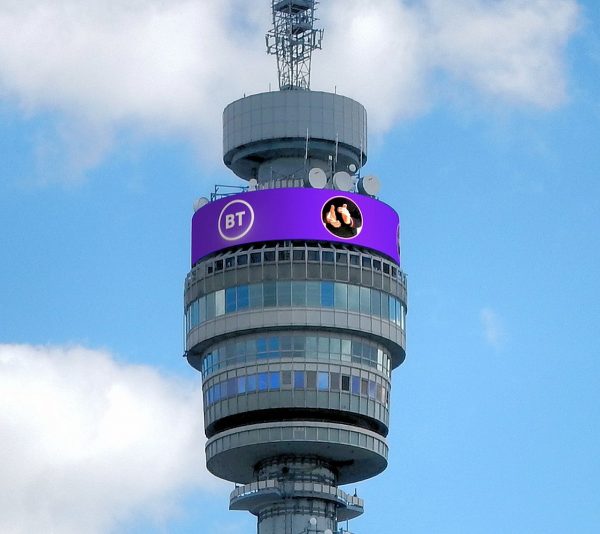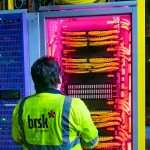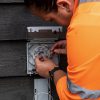BT Group Build 1Gb FTTP Broadband to 4.1 Million UK Premises

The BT Group’s latest Q3 2020/21 results reveal that Openreach’s G.fast and Fibre-to-the-Premises (FTTP) based “ultrafast broadband” (100Mbps+) network now covers a total of 6.88 million UK premises, with 4.05m coming from FTTP alone (up from 3.5m last quarter). The take-up rate for their full fibre services has also improved.
The past quarter as been quite an eventful one for the national operator. Openreach confirmed they would hire another 5,300 engineers and swap all of their vans for EVs (here), but at the same time the CWU have continued to threaten strike action over changes to redundancy terms for job losses elsewhere (here). Meanwhile the CEO of BT Group, Philip Jensen, said that he was “open minded” about the possibility of selling a “minority” stake in Openreach to help fund their £12bn FTTP rollout (here).
Elsewhere, BT launched their new Halo 3+ product to more closely combine the benefits of WiFi, mobile and broadband (here), while Openreach extended their copper to fibre migration path to a second batch of 51 exchange areas (here) and, separately, drew some criticism for a letter they sent to a local authority in Northern Ireland (here). We also got a sneak peek at Openreach’s new 4 port ONT for FTTP lines (here) and the network operator was forced to delay some installs due to the new lockdown (here).
Advertisement
Meanwhile BT has finally signed the last R100 broadband rollout contract (LOT 1) for Scotland (here) and were separately fined £6.3m for breaking Ofcom’s rules during a tender for the recent £50m Northern Ireland Public Sector Shared Network contract in 2017/18 (here). Lastly, Openreach has unveiled plans to close 4,600 UK exchanges (here) and they’re taking TalkTalk to court in a dispute over unpaid bills for Ethernet (here).
Financial Highlights – BT’s Quarterly Change
* BT Group revenue = £5,477m (up from £5,357m)
* BT Group profit after tax = £420m (up from £408m)
* BT Group total net debt = £17,294m (decreased from £17,627m)
Sadly, BT doesn’t report full customer figures for their own retail broadband ISP, but they have started doing it for their newest services. For example, BT Consumer reported that they had 686,000 FTTP customers (up from 598K last quarter) and EE’s “5G Ready” base now stands at 2,141 million (up from 1.23m). Meanwhile 82.3% of BT’s fixed consumer base now take a “superfast broadband” service (down from 82.4% last quarter – mostly FTTC) and this drops to just 4.8% (up from 2.7%) for their “ultrafast broadband” (100Mbps+) products (G.fast and FTTP).
Separately BT’s KPIs also reveal that the total gross BDUK grant funding deferral (clawback) included in capacity/network remains unchanged on £788m. This reflects public money that is either in the process of, or could in the future be, returned by BT and reinvested by councils to help boost superfast broadband coverage. A big chunk of this has already been re-invested into such contracts or provisionally allocated to future ones.
Openreach’s Network
The table below offers a breakdown of fixed line network coverage and take-up by technology on Openreach’s national UK network, which covers the totals for all ISPs that take their products combined (e.g. BT, Sky Broadband, TalkTalk, Zen Internet, Vodafone etc.).
Advertisement
The roll-out of full fibre lines remains the dominant one amongst the two “ultrafast” technologies, with FTTP adding +550,000 premises (up from +521K last quarter) and hybrid fibre G.fast being unchanged. As most people know, G.fast deployments have been suspended in favour of FTTP (due to be reviewed in March 2021, but no change is expected). We note that the FTTP build rate is now 42,000 premises per week (up from 40K).

Openreach claims that there has been a “strong increase in sales in Q3“, with the network access provider achieving a “record” of 17,000 FTTP orders per week. The results reveal that, across all ISPs, some 790,000 FTTP connections have now been made (up from 655K last quarter) and that equates to a take-up of 19.51% (up from 18.71% last quarter) – this is impressive given the rapid rollout pace (take-up is usually suppressed by a rapid deployment).
Meanwhile the take-up of their G.fast service stands at just 6.25% (up from 4.87% last quarter), which is extremely poor given that their rollout of this technology has been on pause for the past year (i.e. we should be seeing much better take-up by now). The decision to focus on FTTP instead was clearly the right one.
Advertisement
Philip Jansen, CEO of BT Group, said:
“During the current Covid-19 pandemic, BT has continued to deliver for our customers and invest in our networks, our modernisation programme, and our products and services in recognition of the ever increasing need for improved and faster connectivity. We delivered results in line with our expectations for the third quarter and remain on track to deliver our 2020/21 outlook despite even greater Covid-19 restrictions than previously forecast. BT has shown again that it has the spirit and determination to step up and deliver for our customers, keeping them connected with a range of initiatives. I am particularly proud of the ongoing work and investments we are making to support school children, SMEs and the NHS during the pandemic.
We continue to make significant investments in our industry leading networks; with FTTP having now passed over 4m premises and 5G available in 125 towns and cities, we’re firmly on track to deliver our March 2021 targets. Openreach FTTP orders accelerated even further to reach another record level of 17k per week. We have demonstrated continued improvement in our operational performance, including acceleration of FTTP and 5G take-up, and customer satisfaction metrics. This reflects our progress in creating valued, reliable, stand out customer experiences and propositions; the next evolution of our flagship convergence proposition, Halo 3+, will drive even further progress.
As the WFTMR2 consultation process draws to a close we’re focused on ensuring the new regulation will create an environment to allow for fair returns across our industry including the additional significant network investment we are poised to undertake. The latest proposals from Ofcom are positive for investment in many areas, but there are key points of clarity still needed to unlock the fibre investment the country needs; and we still need to see concrete progress from Government on the things they can do to support the fibre roll out.
With no material impact expected from the Brexit deal and our resilient results so far this year I remain confident in our EBITDA expectation of at least £7.9bn for 2022/23. Looking further ahead our new Digital unit will enable us to accelerate our digital and business transformation programmes and to deliver digital platforms that bring together best-in-class services for our customers, further securing a brighter and more sustainable future for the group.”
The BT Group clearly has a few challenges ahead of it, not least in terms of a forthcoming clash with the unions over jobs and securing enough funding to help fuel their FTTP rollout until 2025. On top of that Openreach faces rising competition from a growing base of rival alternative full fibre networks, many of which will be bidding against them in the Government’s new £5bn gigabit broadband programme.
On the other hand, we’d say that the road ahead is starting to look a lot clearer, and arguably smoother too, than the road they’ve been travelling down for the past few years.
Mark is a professional technology writer, IT consultant and computer engineer from Dorset (England), he also founded ISPreview in 1999 and enjoys analysing the latest telecoms and broadband developments. Find me on X (Twitter), Mastodon, Facebook, BlueSky, Threads.net and Linkedin.
« Ofcom Details New UK Broadband ISP Switching Process for 2022





















































Will we hear more about new FTTP rollout locations soon? Much of London seems to still be missing.
Sod London I live in a really rural village and need it more. Quite often forgotten, one of the last places to get FTTC…
So both of ya 😀 want more rollout in Brum.
The last update was in September, I was expecting another one by now. Pandemic I suppose. Where I live is scheduled to be fibred up according to the last announcement but I’d be happier knowing a date even if it was years away rather than just left hanging.
I know what you mean Granola, an address I manage has been in Fibre First plans for good year or close to two now, but I think underground cabling across the area is an issue so they seem to be getting on with Overhead lines before tackling the underground.
My Fibre first location seems to be the same. Friends living in streets with Telegraph poles which were marked as fibre enabled (yellow sticker) in Dec or Jan 2021 can now order FTTP however most locations with underground cabling even those that had fibre pulled through in summer 2020 are still o FTTC.
We thus patiently await completion.
@JusyCycling – Hmm you already FTTC, thats good to know, I also live in neighboring area with overhead lines, would be interesting to see if FTTP rolls out round here anytime soon.
Shame can’t say the same for other area with FTTP, underground lines affected can’t get much more than 4mbps, the address I manage is 1.5mbps.
If you are on a buried estate it may be they have not decided to provide at the moment due to the costs involved
I’ve not had confirmation but suspect it is a direct burial estate so likely going to be a while.
Does anybody know or experienced how Openreach typically handle direct burial lines, the best solution in my opinion if to install poles and got overhead but sure that’s not going to happen for whatever reason.
City Fibre will be here before Openreach I think, they aren’t to far away currently in Solihull
2.2m properties passed per year is an impressive rate. If they kept this up, it would imply 100% coverage (~30 million properties total) by end of 2032.
In practice I guess we’ll get to about 70% by end of 2027, and then it will start to tail off due to the higher cost of the last chunk.
Based on my calculations and progress, we should be at around 70% Openreach FTTP coverage by end of 2025. But based on Openreach’ maximum build rate, I would imagine in % terms this could be higher.
Remember that builds tend to have both a ramp-up phase, a peak phase and then a ramp-down phase. On a chart this tends to take the form of a stretched half ellipse, so you can’t assume a linear momentum of future build. It’ll ramp-down steadily before it stops.
Openreach will not have 100%. Many new neighbourhoods and new build developments are being covered other providers protected by covenants in the short term and it may not be commercially viable to overbuild going forward.
In addition is the assumption that OR will replace all copper access with FTTP. They could for instance elect to omit towns where two or more providers (e.g Cityfibre and Virgin) and the related surrounding areas or overbuild with a high ratio socially inclusive speed product.
Finally they are unlikely to venture into non commercial areas awarded to other providers under the forthcoming Out/In procurement.
Much depends on the future costs but the cost of civils and maintaining it isn’t likely to fall.
So an assumption that OR will be one of your future providers is incorrect.
> In addition is the assumption that OR will replace all copper access with FTTP. They could for instance elect to omit towns where two or more providers (e.g Cityfibre and Virgin) and the related surrounding areas
Why would they avoid those areas? Those are the areas where the other providers have “poached” their existing copper customers. By installing FTTP they will be able to get some of them back; and presumably these are dense urban areas which are the cheapest to build to.
In areas where the only existing provision is Openreach copper, then they get a worse return on their FTTP investment: they are only poaching customers from themselves.
They won’t have a choice, move to FTTP in so many years or have no copper service (they don’t have to enter the premises to stop the service the removal of the phone exchange and cabs will do that as well as all the fibre up to the pole or service hatch)
I not sure you right about the Capital Deferral being re-invested in big chunks. There is insufficient work taking place in rural. NAO found £111m and a DCMS WPQ are stating it is being handed back, but the IPSOS Mori report on page86 are reporting LA with zero nominal cost for phase 1. However the latter is not then reflected in the rest of the report, where the role of BT capital is excluded from the analysis on Figure 8.1.
There will be a big opportunity missed in concluding rural works if this matter is not examined. BT has capitalised these costs, claiming it and recovering it as investment but it is not being invested in the network.
When will BT deal with ‘Exchange-only’ broadband line customers who are stuck on ADSL+2.
When they just happen to be in an exchange area that the decide to upgrade to FTTP. No company has a concrete plan to replace EO lines unfortunately, and even the government’s emphasis is now on spreading gigabit broadband as widely as possible rather than getting everyone at least a superfast connection. I suspect BT/OR may prefer altnets to cover many EO areas, as the loss in business will work out cheaper than the cost of upgrading those areas.
I was on an EO line, but we had a cab built for us to have FTTC, but now I suspect due to that we won’t get FTTH being rural as well for years. I’m banking in 5G coming sooner may be best for you too? Ditch BT and copper lines all together then.
My house has a line length of about a kilometre to the FTTC cabinet, which itself is situated about 100m from the village exchange. There is an area of housing on the other side of the exchange to us which only has ADSL2+ and I presume these are exchange-only lines. I theorise that if there was VDSLAM in the exchange then these EO properties would have reasonable line lengths for VDSL, some shorter than mine in fact. Is there a technical reason why this wouldn’t work, or is it just a matter of OpenReach policy not put VDSL equipment in exchanges?
IIRC its Ofcom policy that prevented it – the fear of VDSL interfering with other services. Presumably if it had happened, they’d have to use line profiles that reduce the risk of that interference, and hence provide worse performance than simply sticking a cabinet right outside the building.
Some weird EO choices though. I’m aware of someone whose EO’d line got an FTTC cabinet. His “rear neighbour” on another street was not EO and went straight up to FTTP. I’m also aware of some very rural EO lines (several miles) that got FTTC even though there probably wasn’t many homes that could benefit
They aren’t allowed to install VDSL2 kit inside the exchange building but they get around this by putting them right next to the exchange.
There’s probably hundreds of exchanges with VDSL2 DSLAM’s right outside. Some on the public street, others appear to be literally in the exchange car park.
There’s no risk of interference with ADSL services.
They already apply PSD masks, DPBO, UPBO, to every single FTTC cabinet in the country to prevent interference with ADSL signals (they share the same spectrum).
Every cabinet has a CAL value (Cabinet Assigned Loss).
The CAL value determines the power levels that VDSL2 is transmitted at on the ADSL tones. That CAL value is based on the ESEL, E-side Electrical Length (distance from the exchange).
For FTTC cabinets that are in the grounds of the exchange (but outside the building) simply have a lower transmit power for the tones that share frequency/spectrum with ADSL services.
For cabinets that are miles from the exchange the ADSL will be much weaker by the time it reaches here, allowing VDSL2 to use slightly higher power levels
If you’ve ever looked at the bit tones in use on an OpenReach VDSL2 service some 9f this is very obvious by the notch of tones missing in the D1 band of every single line.
There will be very little (or none at all) FTTC used for EO lines in future.
The focus is very much on FTTP.
Openreach state that i can have FTTP on their Website…. but when you try and get a FTTP installation, BT say i can’t have FTTP it’s not available, Sky the same, in fact all of the providers state the same thing FTTP is not available… So can openreach please state the truth. very poor.
Are you sure it’s FTTP and not FTTPoD?
But if it is FTTP then it’s possible it’s not at the order stage just yet.
There has been stop on most installs due to the Covid lockdown. Orders may start again next month, depending on the national lockdown .
Lets be honest though… The majority of the Rollout has been to New Build Developments which makes the figures less impressive than they actually are.
500k have been fully subsidised in rural, and BT is preferring to hand back monies it owes(clawback and capital it was supposed to invest) rather than complete rural. This was confirmed by DCMS in this WPQ 126868.
Peculiar in the middle of recession when take-up of 70% is pretty much guaranteed.
Utter rubbish.
News to me Steven. The fibre that OR are slowly running along my street must be to serve the non-existent new builds. The newest homes are probably 10 years old at this point
Some percentage of it might be new builds but there’s a hell of a lot of so called “brown field” FTTP now.
excuse me how you know that The majority of the Rollout has been to New Build Developments
more disinformaiton as ever
@Steven
Quote “The majority of the Rollout has been to New Build Developments which makes the figures less impressive than they actually are.”
A cursory check of the excellent and regular analysis undertaken by Andrew at Think Broadband suggests that FTTP to new developments accounts for around 10% of the total, so hardly the majority (see the post on 12th January for the latest breakdown). Sometimes opinions are not founded on facts!
@NGA
Quote “500k have been fully subsidised in rural, and BT is preferring to hand back monies it owes(clawback and capital it was supposed to invest) rather than complete rural.”
Not surprising at all as this is what would be required by the contracts with the local authorities. A supplier cannot choose to spend money without the support of its customer! And, since the BDUK project never was about rural (the “final third” covered a fair amount of urban premises too), “completing rural” was never an option anyway.
As you will presumably know, any additional coverage would have to be agreed first, may have to be re-tendered, and can only extend to premises within the agreed intervention area as defined by the OMR (which in turn may need to be re-done if out of date). It is simply not permissible to spend up to the available budget irrespective of value for money, state aid rules etc – there are quite a few pressures on our tax monies at the moment!
New_Londoner …BT did choose to inflate its costs (38% according to the NAO in 2015) ..did withold its capital contribution from the Phase 1 and indeed phase 2 planning process and then decided to capitalise all it owes (the capital deferral) and is now not bidding to do in-fill work – Devon Somerset, North Lincs and fails to win £165m to in-fill 80k premises in NI.
A programme that used to be called a rural broadband programme is clear enough with an objective to go as far as possible. Diverting monies to urban can be tolerated if the money is recycled.
Your argument is pointless as we are only 500k English properties needing to be put under contract from getting to beyond 99%. Why go to the trouble of creating a dodgy accounting treatment for the monies owed at the expense of letting Openreach completing the works required?
@NGA
You keep stating that costs were inflated, are you really suggesting that the itemised audit undertaken by the BDUK team and local authorities was totally inept and that you have special information unavailable to them? If so, I suggest that you contact the BDUK team and provide that information so that they can investigate rather than pontificating on here.
As to not bidding everywhere, taking Devon and Somerset as an example, I wouldn’t either. I wouldn’t want to waste my time and resources bidding when the process is being run by an incompetent team that has failed on two previous occasions. I’d invest my resources elsewhere.
You keep insisting that the BDUK programme was really the rural broadband programme. The then government published its “Britain’s Superfast Broadband Future” document in December 20210 and this states “To achieve our vision, we need superfast broadband in rural and urban areas and we are committed to driving superfast broadband services into areas
where commercial investment alone will not deliver it”. It also makes reference to the final third and the need to avoid a digital divide, does not say that the focus needs to be on rural.
As to your final point: “Your argument is pointless as we are only 500k English properties needing to be put under contract from getting to beyond 99%”, you continue to ignore the niceties of contracts, budgets, value for money, state aid rules etc. Thankfully others are less cavalier when it comes to such matters, perhaps they are better suited than you to make decisions based on facts and real data rather than on conjecture, extrapolations and misunderstandings.
Nw_Londoner The NAO report in October 2020 highlights some now £900m in ‘clawback’ which includes the newly defined ‘operational clawback’- which is some of the capital owed. This as opposed to the profit share.
There were and are highly levels of normalised deviancy imbedded in how BT Group chose to work these contracts. That has been established in eight Parliamentary inquiries.
The need to get another 500k premises under contract should not require an entirely new programme when so much money is owed.
@NGA
Quote “The need to get another 500k premises under contract should not require an entirely new programme when so much money is owed”.
You do seem rather cavalier when it comes to niceties such as contracts and state aid rules! I’m sure that the contracted parties, particularly the local authorities, would want to have a say in how any monies owed to them are spent.
You’ve also ignored other points relating to, for example, why many businesses would choose to no-bid when a tender is run by a failing authority and why BDUK was always more than a rural broadband programme.
New_Londoner – The state aid measure and the nature of gap funding if properly applied would define the programme as rural. The fact money leaked to urban was an illustration of abuse occurring under the commercial confidentiality process.
It is less about Devon and Sommerset and move about how BT Group are failing to grasp its role as a nominated provider of a Universal Serive Obligation for Broadband.
Contracts are relationships of trust. When that breaks because of the lies told on costs and BT’s capital then outcomes are sub-optimal for everyone.
On state aid, the resources existed for much more than 90 or 95% contracted. BT Group preferred to game the process and 8 inquiries later – BT is paying back ~£900m leaving the job unfinished and a whole bunch of newly funded pretenders. Congrats.
New_Londoner
One other reason to turn up is that BT has already capitalised all the money it owes. This mean it is pretending these monies have been invested in the network when the money does not touch the network. This increases the opportunity cost for Openreach to turn up.
This ‘accounting treatment’ would not be tolerated in Italy or USA.
@NGA
Quote “New_Londoner – The state aid measure and the nature of gap funding if properly applied would define the programme as rural. The fact money leaked to urban was an illustration of abuse occurring under the commercial confidentiality process.”
That is just plain wrong. The government defined the broad areas covered by the BDUK programme, which excluded the main metropolitan centres plus the entirety of the London region. The OMR process then confirmed where there were credible commercial plans to deploy by any network provider within the next three years.
Or are you suggesting that the then government, all of the local authorities and all of the network providers were in on this conspiracy?!
And your point about the broadband USO is a complete red herring. This is a separate obligation and it would obviously not be possible to take monies owed to local authorities under the BDUK contracts and spend it on USO. As I said, you appear to have a cavalier attitude towards contracts, state aid rules etc.
Our exchange is 1Gb enabled but they decided too downgrade my street too 300/50 even though my next dour neighbor (semi detached) can still get 1Gb – maybe need to chat with my local MP
You may wish to check first whether this is a network limitation or a commercial decision by your ISP – if it’s the latter then try shopping around.
Now why would a limitation be in place when more money can be made selling the faster product…. Normally would suggest there’s an issue with capacity and they wouldn’t be able to provide the service…. Of course you could force them to sell it then not get the service you want.
Go to Virgin of that’s the sort of half cooked service you want.
Just because a road is reported as Ultrafast or Giga capable does not mean the residents can all get access to those speeds. If FTTP has been provided say with an optical splitter that has a specific capacity then the network provider can only offer a mix of products that collectively meet the minimum product speed guarantees. OLT Bandwidth (Down) + Dynamic Bandwidth Algorithm (Up).
As previously stated applies to other technologies e.g VM in my street where only 40% can get VM currently despite VM covering all.
Providers will apply different capacity depending on take-up and product forecast.
My recommendation is if FTTP comes down your street jump in and become an early adopter before the first wave of investment is exhausted.
@JP
Quote “Now why would a limitation be in place when more money can be made selling the faster product”
In the same way that some ISPs have yet to offer any FTTP products at all, some may prefer to limit their FTTP offerings to slower speeds rather than pay for the necessary connections. They may believe that they can achieve higher margins by sticking with mass-market services, leaving higher-end options to others.
This is a poor figure, nothing to be proud of. The majority of this backwards country still does not have available fibre broadband. This country is more than a decade behind of where it should be by now. It’s time to introduce a different strategy and treat fibre as an eseential utility, as is the case with electricity or water.
What would that strategy be? Do the VM upgrades count?
A great figure keep up the good work BT.
It’s an impressive build rate and every sign it will continue or even accelerate.
No doubt we as a nation would be further ahead if the government had not interfered , resulting in an almost complete halt of FTTP build for 5 years whilst BDUK was delivered.
David hood — had FTTP carried on being delivered during BDUK the country woudl have significant less >30 m/bps broadband as delivering significantly less premises costing sigifincantly more money is not good practice ,, note that openreach original way of delivery was via manifold and manifolt , not its significantly different and cheaper and Faster – hence the FTTP numbers are as they are
@The Facts: “What would that strategy be? Do the VM upgrades count?”
Same lame questions again here? This was already answered a while ago if you can be bothered to do a Google search.
Anyway, is there a reason why you still consider fibre broadband of not being an essential utility?
Not everyone has mains water or mains electricity.
Equally not everyone has effective access to broadband and are not covered by current initiatives as it is also deemed too expensive and you can build a new house with none of the above.
Politicians only look at the percentages which improve each year only because of the rate new houses being built with large government subsidies for provision of utilities.
At least a domestic water supply and an electricity supply is specified and if present is understood to be more than enough for normal use. Broadband availability is and will remain a lottery for both technology, speed and ISP choice.
Look at history Margaret Thatcher is directly responsible for the slow internet speeds within the UK, stopping BT showing vision over its Network for years, preferred to allow USA cable companies access to the UK market in the name of competition,other countries with FTTP have not done this, bad move by Thatcher imo.
She set us back 35-38 years because of that (it was 1992 now aim is 2025 (more likely be around 2030 before copper is fully gone) fttc is a cheap dead end technology
so talking someone from 2 meg up to about 50 / meg is a waste of technology
whcih is why >95% is greater that 30 M/eg
unbelievable
I’ve always found it hard to believe that was ever a realistic proposition 30 years ago. BT were never going to be allowed to use if for broadcast tv and the internet was barely a twinkle in Tim Berners Lee eye. And just what sort of distribution system did BT intend to use, TPON!!
Ive often thought Dr Cochrane to be something of a fantasist. No doubt there were intentions to lay a lot more fibre but probably targeting major business areas and probably a lot more TPON, and look where that ended up.
And Thatcher was gone in 1990 so plenty of opportunity to change policy .
As I have commented before it still annoys me that with so much of the UK still not having FTTP in urban and metropolitan areas that instead of covering these new areas Openreach prefer to go Chasing over the same areas as other providers.
The Rushey Mead and Hamilton area of Leicester being a prime example, CityFibre have just spent last 3 months putting in FTTP now suddenly Openreach have decided they are going to cover the area themselves where as previously they were not interested and annoyingly there is vast amounts of other areas around Leicester that are not in CityFibre plans for Leicester but Openreach won’t fibre these
Openreach is a commercial company and will prioritise their resource and investment. Their key focus has to protect their revenues needed to maintain wider investment. Unfortunately both are restricted so they are probably focusing on areas driven by marketing data and engineering need.
Leicester is currently not a OR Fibre First location although there will be new build and other initiatives. OR were due to upgrade FTTC/FTTP provision in November and FTTP may be being used tactically to reduce FTTC load.
I also note parts of Rushey Mead and Hamilton have no VM competition which may be a factor.
jamie simms
openreach decide where spend there money on the greatest commercial return (based on the expected payback period)
any network operator would do the same
areas that are not commerciailly viable or a expected rate of take up would not take place wont be covered (by anyone) that plain hard nosed commercial economics
Meadmodj- There are lots of areas in Leicester that have high FTTC utilisation and some that have no FTTC like like parts of Birstall and Glenfield so to me if Openreach want to do some mass areas for consumer and government benefit these areas should be done first.
All that has happened in Rushey Mead and Hamilton is OR Have seen oh we have a FTTP competitor let’s try to take some business away from them. Although they are probably going to miss the initial boat as CityFibre is live now and is just waiting for some other areas to finish the build before the city wide launch of CityFibre. So I expect them to get a large amount of the initial business and the users desperately needing the speed.
These are classified as commercial areas. It will all depend on the forecasted market share. OR can probably just about hold its own for now (driven by ISP choice) but for the next few years those requiring higher speeds will opt for Cityfibre or an upgraded VM. The issue is that once OR has completed its FF towns/cities and diverted attention to Outside/In they will no doubt return to Leicester and will reappraise their situation at that point. Equipment prices may have dropped further but if Cityfibre and VM have significant take-up between them then it may be unprofitable to cover all of Leicester with OR FTTP.
Both VM and Cityfibre have no obligation for 100% coverage or capacity so some will be dependant on DSL for a long time.
At each stage of Broadband we have had Haves and Have Nots and these are changing again. The big issue will be for premises left out in commercial areas unless Ofcom raises the USO and placers some obligation on the Altnets. It’s unreasonable it should all fall on OR if they have the lowest market share within the location.
We border slough to the north in Farnham Royal yet we have been badgering Openreach since 2012 to get FTTC but they say they have “no plans to upgrade our cabinet to FTTC or give us FTTP”. Yet next door in Slough there are 3 competing providers including OR rolling out FTTP to the whole city, as well as O2 and 3/EE 5G masts being installed to add to the existing VM + BT FTTC. What is going on?
There appear to be 600 premises connected to our Farnham Royal cabinet (#6), with the majority getting <5Mbps download and <1Mbps upload. We are 1 mile from our fibre enabled exchange in Farnham Common (to the north) with I believe ducting going all the way from the exchange to within a few metres of our cabinet.
Can anyone here explain what Openreach (and DCMS?) is playing at prioritising upgrading existing FTTC homes to multiple FTTP options when they have 600 households desperate for any form of fibre next door?
PS: Farnham Royal is not a rural area, in fact it is quite dense suburban. Consequently we don't fall under the USO funding for community fibre partnerships.
If you have any advice on how to proceed getting OR to change their mind please let us know! Our residents and MPs for 8 years have got nowhere with OR or DCMS!
Re: Farnham Royal. The USO applies to anyone the country with a sub 10Mbits connection. Doesn’t matter if you are urban or rural.
fight for fibre
USO is nothing to do with CFP
if there are that many you good get you community together to fund it for FTTP as its not on any commercial programme– some individual roads i understand have already done that on the “infamous Farnham common 6” area
@Fastman: “fight for fibre ”
Really? What kind of advise is that? Perhaps we should also fight for electricity? Or water?
Customers should not have to be victims of the telecoms’ postcode lotteries here.
This just shows how the whole telecoms framework has been a failure in this backward country.
@GNewton
Quote “@Fastman: “fight for fibre ”
Really? What kind of advise [sic] is that? Perhaps we should also fight for electricity? Or water?”
This made me laugh, it was a reference to the chosen name of a previous poster rather than advice from Fastman.
More seriously, you keep complaining about “this backward country”, what are you doing to address these perceived shortcomings beyond posting on the Internet?
@New_Londoner: “This made me laugh, it was a reference to the chosen name of a previous poster rather than advice from Fastman. ”
Apologies, I should have read it more carefully.
Anyway, the point is customers should not be victims of poor telecoms services, nor should they have to campaign for them. While it is commendable if some do (e.g. CarlT and others, we did too, in the past) this is not normal. In the end we just moved office many years ago to a place where telecom services are available.
I really do wish there was a way everyone could come together to install one shared fibre network for all. Overbuild is terribly wasteful on many levels and results in inferior networks.
Imagine if we all come together to install one network that was shared by all. Symetrical 10Gbps for all would be easy. Share the job, cost and profits. Instead of redoing work that’s already being done and spending money that’s already being spent.
I guess the choice of 3+ seperate FTTP networks is a good thing in the long run but damn how much quicker could everyone have FTTP without all this overbuild.
Well there was Openreach but nobody wanted to play ball.
You’re describing a cartel – people go to prison for a long time for operating one.
Symmetry has two ‘m’s.
Like Transco or whatever they are called now? Way too late now.
I don’t belive it is too late. Where there is a will there is a way. Ok maybe it’s too late to for some areas but it could be done in many others.
Imagine all the benefits like lower maintenance costs with one network to maintain, resilience becomes a lot easyer to build in as well. It’s just a win all round for everyone, both on initial build and maintenace.
Anyway tis but a dream.
But then that’s not one network for very one to use is it.all your doing is trying come up with a way of getting a faster speed for yourself quicker instead of actually thinking of the bigger picture (other people) and the long term aspect.
“one network that was shared by all”
While this is a reasonable idea, there’s too much of a “Cant’t Do” mentality in this backwards country. Just take a look at this forum thread. Some posters even try to blame the long-dead Thatcher for the fibre farce, not realizing that nobody has prevented telecoms from building fibre for over a decade now. Look at how many years it took for BT to finally come up with its belated Fibre-First programme.
And yes, building multpile fibre access networks in some areas, while a vast majority in other parts has no fibre, only highlights the fact that the whole government framework was wrong and wasteful with regards to fibre utility. We don’t build multiple water pipes and electricity lines from different utility providers to the same premise, do we? Why this madmess with fibre?
“not realizing that nobody has prevented telecoms from building fibre for over a decade now”
Nobody has prevented any other telco. But ofcom and other telcos have stifled BT.
Anyone in a “Fibre First” location might want to track OpenReach activities on a site like roadworks dot org.
My home town has seen literally dozens of Openreach-attributed roadworks in the last 3 months for such tasks as clearing blocked ducts, installing swept tees & replacing poles. All necessary before fibre gets “blown in”, I understand.
“BT Group revenue = £5,477m (up from £5,357m)”
“BT Group profit after tax = £420m (up from £408m)”
whats the profit before tax?
We in a small village in east Hertfordshire, some have fibre, all the rest that are close to cabinet still have copper that is ok at best. I run online business and youtuber from home and need bandwidth. Lucky to get 15mb up, that is nothing for livestreaming. I want to know why openreach replaced overhead cables with copper recently and not fibre. I asked the guy and he said unlikely get fibre as you are close to cabinet, so basically open reach brand all customers the same saying everything is ok with 15mb up.